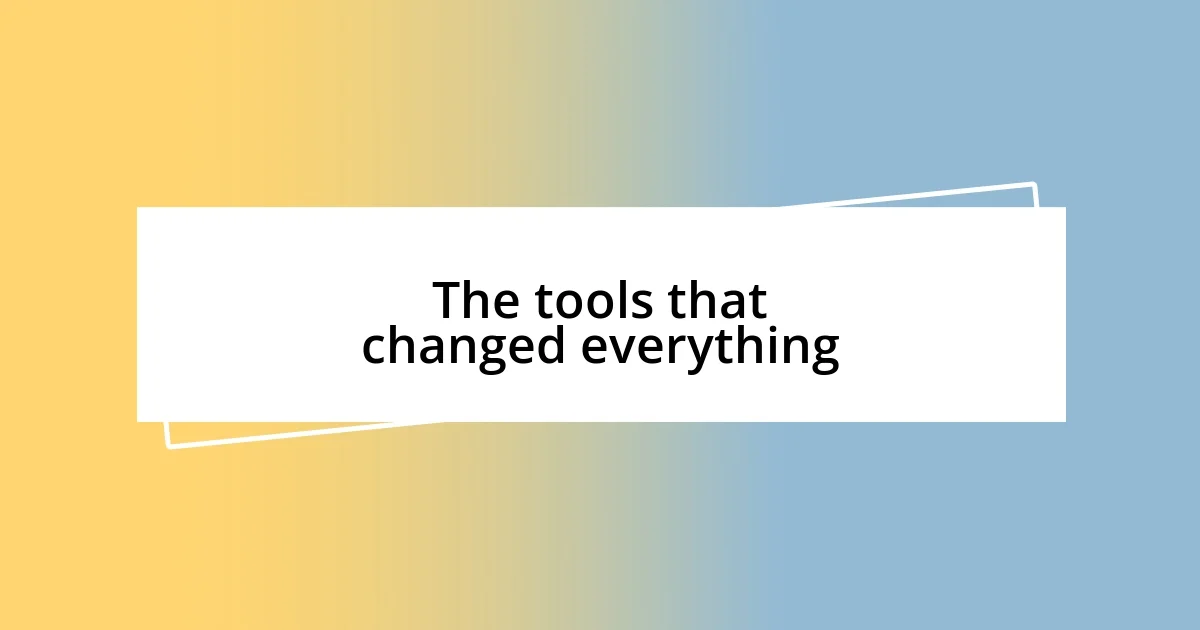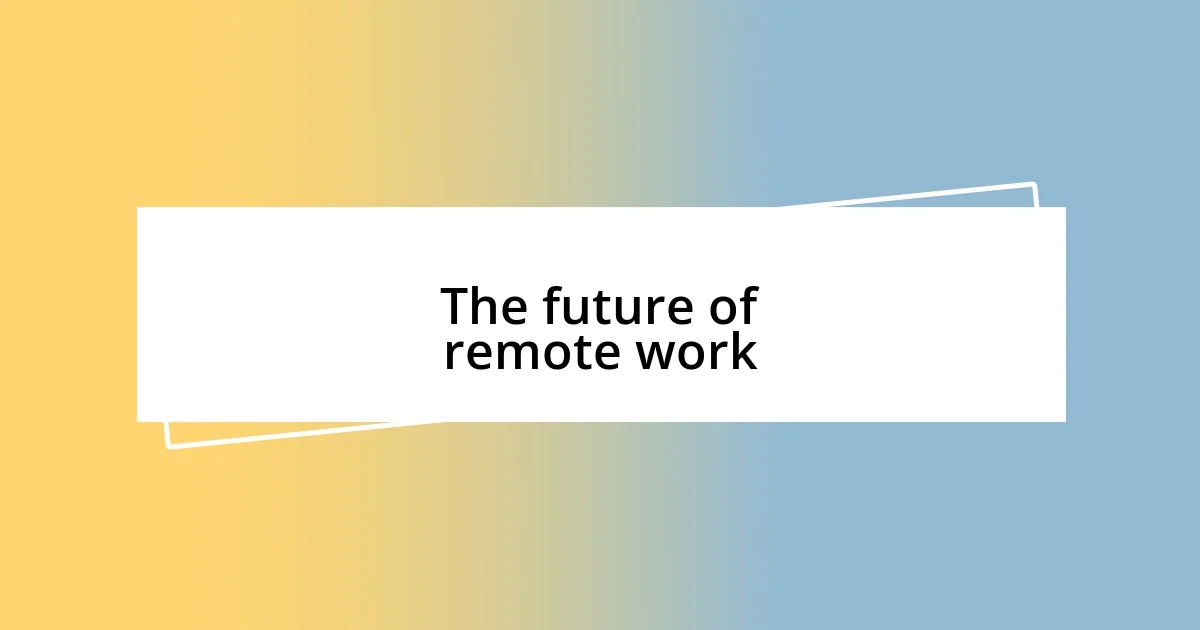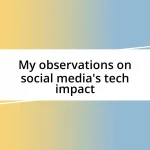Key takeaways:
- Transitioning to remote work technology, such as Slack, Zoom, Asana, and Google Drive, significantly improved productivity, collaboration, and team accountability.
- Creating an ergonomic and personalized home office environment enhances comfort and productivity, while maintaining work-life boundaries is essential to avoid burnout.
- The future of remote work will be shaped by advancements in virtual reality, artificial intelligence, and hybrid work models, promoting flexibility and evolving collaboration methods.

Understanding remote work technology
Understanding remote work technology is like navigating a digital maze; it can be daunting but incredibly rewarding. I remember when I first embraced tools like Slack and Zoom. The initial learning curve felt steep, but the thrill of connecting with colleagues from different time zones ignited a passion for collaboration that I’d never experienced before.
I often reflect on how these technologies have transformed my work life. Remember those long, tedious commutes? With video conferencing tools, I can now have meaningful face-to-face meetings without leaving my home office. This shift not only increased my productivity but also gave me back precious hours to spend on hobbies or with my family.
Isn’t it fascinating how remote work technology fosters a sense of community, even when we’re miles apart? For me, using project management software became a game-changer. I was initially skeptical about sharing tasks and updates in a virtual space. Still, it quickly turned into a source of accountability and motivation, reshaping the way my team and I collaborated, even from afar.

The tools that changed everything
The evolution of my work life owes a lot to the powerful tools that emerged. When I stumbled upon Asana for project management, I was both hesitant and intrigued. I remember the first time I set up a project there; seeing tasks flow through the stages made my work feel more organized and less overwhelming. It was the moment I realized technology could work for me, rather than the other way around.
Then came the revelation of cloud storage solutions like Google Drive. I can’t tell you how many times I lost sleep over lost files or messy email chains. Transitioning to a shared drive felt like a breath of fresh air. Suddenly, everything was accessible, and collaborating on documents in real-time with my teammates felt like we were all in the same room. That shift not only boosted our efficiency but also rekindled the joy in teamwork that I had missed.
Finally, let’s talk about how video conferencing tools, especially Microsoft Teams, blended functionality with camaraderie. I can vividly recall Thursday mornings filled with team video calls, bantering about our weekend plans before diving into our agenda. Those moments created connections that transcended the screen; they reminded us we were more than just colleagues. With these tools, remote work transformed from a lone endeavor into a shared journey, filled with laughter and encouragement.
| Tool | Impact on Remote Work |
|---|---|
| Asana | Enhanced task management and accountability |
| Google Drive | Streamlined file sharing and collaboration |
| Microsoft Teams | Boosted team camaraderie and communication |

Setting up your home office
Setting up my home office was both a joy and a challenge. I remember eagerly opening the boxes of my new desk and ergonomic chair, feeling like I was investing in not just a workspace, but in my well-being. Proper ergonomics cannot be overstated. I learned the hard way that spending long hours in a haphazard chair led to back pain and fatigue. It’s essential to create an environment that’s both functional and comfortable—this will boost your productivity and overall mood.
Here are some key considerations for your home office setup:
- Desk and Chair: Invest in a sturdy desk and an ergonomic chair that provides adequate support.
- Lighting: Ensure you have good lighting—natural light is ideal, but a quality desk lamp is also beneficial.
- Technology: Set up your computer, monitor (if needed), and necessary peripherals like a good keyboard and mouse.
- Organization: Use shelves, filing systems, or organizers to keep everything sorted and easy to access.
- Personal Touches: Add items that inspire you, like artwork or plants, which can help make the space feel welcoming and motivating.
Creating a productive oasis in my home really made a difference in how I approached my work. I recall how personalizing my space with family photos not only made it feel unique but also provided warm reminders of what I cherish during intense work sessions. Finding that balance between professionalism and personal touch helped me forge a connection to my workspace, making the hours spent there feel more purposeful and enjoyable.

Best practices for virtual communication
Effective virtual communication is an art that I’ve honed over time. One of my best practices is to always clarify the purpose of my message upfront. When I send a quick message, I add a brief context—it’s like giving a virtual hug before diving in. I often wonder, how can clarity help us avoid misunderstandings? My experience shows that being upfront about what I need or expect can significantly reduce back-and-forth chatter and keep everyone on track.
Additionally, I’ve learned the power of active listening during virtual meetings. Sometimes, it’s too easy to focus on what I want to say next rather than truly engaging with others. So, I make it a habit to paraphrase what someone has just shared; it not only shows that I’m listening but also helps to confirm my understanding of their point. Have you noticed how this simple shift can create a more collaborative atmosphere? Trust me, when team members feel heard, the whole dynamic improves, and creativity flourishes.
Another practice I swear by is setting regular check-ins. These virtual touchpoints, albeit brief, have been a game-changer for maintaining relationships and keeping projects aligned. I can still recall a time when my team missed important updates simply because we let our busy schedules dictate our communication. Instituting weekly video calls transformed our workflow into a rhythm of accountability. Isn’t it amazing how just a little structure can lead to a more harmonious collaboration?

Managing time and productivity
Managing time and productivity in a remote work setting has been a fascinating journey for me. At first, I struggled with the blur between personal life and work. I found myself working late into the night, thinking I was being productive, but I often felt drained and uninspired. I started using a simple technique: setting designated work hours and sticking to them. This created a healthy boundary, allowing me to recharge mentally and physically. Have you ever felt that sense of freedom when you finally click “off” and step away from your desk? It’s refreshing!
Using tools to manage my time has also been pivotal. I discovered digital planners that help break my day into manageable chunks, which I find incredibly liberating. I remember using a timer for focused work sessions—a technique called the Pomodoro Technique—where I would work for 25 minutes and then take a 5-minute break. Initially, I thought it would disrupt my flow, but instead, it rejuvenated my concentration and actually made me more efficient. Isn’t it interesting how a small change in approach can yield significant results?
Moreover, I’ve learned the value of reflecting on my productivity at the end of each week. I take a moment to assess what worked and what didn’t. This not only helps me adjust my strategies but also provides a sense of accomplishment as I celebrate the wins, no matter how small. One week, I realized that during morning hours, I was more productive with creative tasks, while afternoons were better suited for meetings. It’s a simple tweak, yet it dramatically shifted how I approached my workload. Have you ever taken the time to analyze your patterns? You might be surprised at what you uncover!

Overcoming common challenges
Overcoming challenges in remote work has been a learning curve filled with unexpected lessons for me. One hurdle I faced was feeling isolated, which could be demotivating. To combat this, I made an effort to reach out to colleagues for casual coffee chats—virtual or otherwise. Have you ever realized how a simple conversation over a cup of coffee can reinvigorate your spirit and strengthen bonds? That small act made a world of difference in forging connections and maintaining morale.
Technical issues have also reared their heads, sometimes at the most inconvenient times. I recall one particularly frantic scenario when my internet dropped right before an important presentation. Rather than panic, I learned to have a backup plan in place, like having a mobile hotspot ready. Isn’t it funny how preparation can ease tension? This experience taught me the value of being resourceful and staying calm under pressure, which is essential in a remote setting.
Lastly, maintaining work-life balance proved to be a challenge, especially when distractions lurked at every corner. Early on, I found myself replying to emails late at night, causing burnout. By setting strict boundaries—like designating my workspace and creating an after-hours ritual to signal the end of my workday—I reclaimed my personal time. Doesn’t it feel refreshing to truly switch off and enjoy your evening? This shift not only boosted my productivity during working hours but also enriched my personal life.

The future of remote work
The future of remote work feels more dynamic than ever, shaped by technological advancements and changing workplace norms. I can’t help but feel excited about the prospect of virtual reality collaborations. Imagine attending a meeting in a digital space, fully immersed, interacting with colleagues as if they were physically present. This leap forward could eliminate the isolation that often accompanies remote work. Have you thought about how such an experience might change your daily routine?
Artificial intelligence is also playing a significant role in streamlining remote work processes. For instance, chatbots can handle routine queries, allowing us to focus on more complex tasks. I remember struggling with repetitive emails that ate up my time, but now, the integration of smart tools has lifted that burden. This shift not only increases efficiency but also opens the door to creativity. Isn’t it amazing how technology can free us to do what we love?
Moreover, I see a trend toward hybrid work models, blending in-office and remote work. This flexibility seems like a recipe for success, but it also requires a mindset shift. I’ve had to adjust to the idea that collaboration may look different now—more asynchronous and reliant on digital communication. Have you experienced this change? Embracing these shifts could help us evolve, fostering a sense of community that fuels both productivity and personal well-being in this new era of work.













